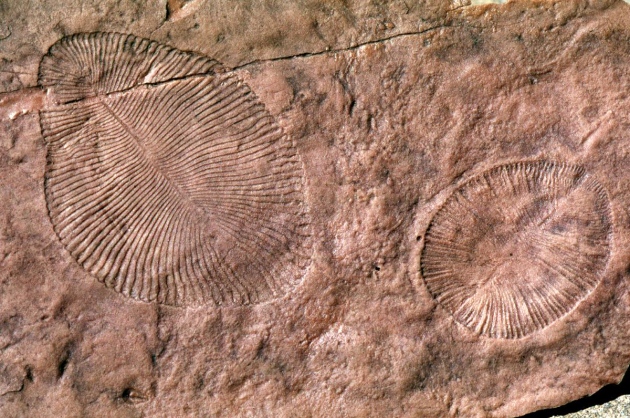We're open daily! View holiday hours
Science News
Marine or Terrestrial?
January 17, 2013

Fossils found sixty years ago are creating controversy. Again.
The fossils date from 542 to 635 million years ago and, since their discovery in 1947, have been described as marine fossils. Now, a researcher at the University of Oregon believes new evidence prove the fossils to be terrestrial—making them the first terrestrial fossils ever. If true, it would mean that life on land evolved 10 to 100 million years earlier than previously thought.
But the caveat “if true” is quite a big question. Could they possibly be terrestrial? I spoke to the Academy’s Peter Roopnarine about this latest hypothesis, published last month in Nature.
“The fossils in question date to the Vendian and earliest Paleozoic—just before and in the earliest days of the animal fossil record that begins with the Cambrian Explosion,” Roopnarine explains. “The fossils are usually referred to as the Ediacaran Fauna, based on the region of their first discovery in Australia. But they have since been found all over the world.
“They are extremely important because they give us our first material evidence of complex life forms on Earth, either many-celled colonies of eukaryotic organisms or true multicellular organisms,” he adds. “They are evidence that the world was changing dramatically, and really set the stage for the next big leap, the Cambrian Explosion.”
Given this description of these fossils, it’s easy to understand why the newly proposed definition—from marine species to terrestrial species—is a big deal. In addition, the author of this new study, Greg Retellack, has been making this claim for years. The latest study is just further evidence for this claim, according to Retellack.
Using chemical and microscopic techniques, Retellack studied numerous Ediacaran fossils and claims that the diversity reflects a preference by the ancient organisms for “unfrozen, low salinity soils, rich in nutrients, like most terrestrial organisms.” In other words, the soils that these organisms inhabited were terrestrial, not underwater. His study determines that instead of ancient marine creatures, these fossils could have been lichens, microbes, fungus or slime molds.
Roopnarine disagrees. “I don't lend much credence to the hypothesis. As indicated in a Nature News piece, there is very little sedimentological evidence to support Retallack's claim. He sees fossil soils, but every other independent study concludes that the sediments are marine. I also do not buy the lichen or slime-mold ideas. The fossils show a great deal of organization of the bodies. They are recognizable as particular species wherever you find them. At best I would say we’re seeing a highly organized fungus, but a more likely explanation is a combination of early animal body-plans and maybe some other branch of the multi-cellular eukaryotic tree of life that subsequently went extinct.”
Nonetheless, Roopnarine isn’t surprised at the lasting debate over the fossils. “Arguments and competing hypotheses can last for decades, sometimes a century or more in science,” he explains. But, for him, weighing the evidence clearly sides with these Ediacaran fauna as marine species. “Because the Ediacaran fauna is so unlike anything else that we know, we will never truly be able to settle this and say exactly what they were. But we can at least say what is consistent with the data that we do have, and the data here do not support a terrestrial setting, nor, in my opinion, a fauna of terrestrial lichens.”
Image: Greg Retallack